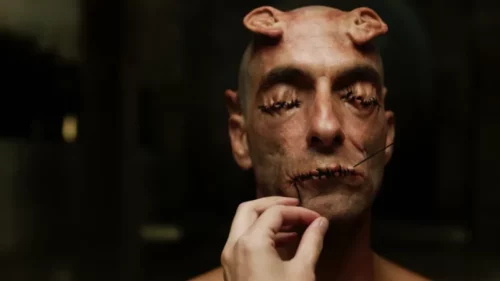Lest anyone fear that David Cronenberg wasn’t still David Cronenberg, he’s back with Crimes of the Future, his first movie since 2014’s Map to the Stars, and this time he’s brought the gloop. Crimes of the Future, which shares its name (and little else) with one of Cronenberg’s earliest (and little seen) films, feels like a direct extension of Shivers, Scanners, Videodrome, and eXistenZ, with its viscerally disturbing tale of a near future in which the next phase of human evolution is occurring in the rather unpleasantly techno/sexual manner Cronenberg has long employed.

It’s pretty good! I mean, for an old guy like Cronenberg. Clearly age has not tempered his obsessions. This time out he brings us to a near future where humans have been rather troublingly growing new organs they don’t know what to do with. Keep them around and who knows, people might start passing on new genetic information to their children, and then where will we be? Someplace other than human. The new flesh, maybe?
It’s not really any kind of spoiler at all to tell you that the movie ends identically to Videodrome, but in a considerably more low-key fashion. Cronenberg is big on humans going to the next stage, and that stage never appears very attractive, does it? We’re all going to end up as one big, squishy Brundlefly is the message, forever fused with whatever tech is handy.
The tech in Crimes of the Future is mostly limited to a number of strange beds in which surgery and art and sex may be simultaneously performed–they’re the same thing, after all–as well as the breakfaster chair, which looks like what a baby Mugwump might be cradled in. Watching Saul Tenser (Viggo Mortensen) try to eat breakfast in it is like watching a stick bug having a seizure with a plate of hospital food in its lap.
Saul is a performance artist with his partner, Caprice (Léa Seydoux). He grows new organs in his gut, and she cuts him open and removes them while an audience of art appreciators oohs and ahhs. It’s kinda gross, though CGI blades cutting into CGI flesh lessens the impact. It’s also very clinical. Cronenberg has long been called clinical for the look and vibe he brings to his movies, but here it’s more front and center. It feels less sexual than his other, similiar movies. Sex fuels it, but it’s as through sex has already moved on, whereas earlier there was still something recognizable about it, something human, let’s say. Here we have National Organ Registry employee Timlin (Kristen Stewart) creepily whispering that “Surgery is the new sex,” and that’s just how it’s presented. After the film’s lone kiss, Saul pulls away, and says he’s not very good at the old sex. Looks like nobody in this future is.

The future looks like it does in every classic Cronenberg movie. Simple, run down rooms. Little in the way of screens or tech, aside from the weird operating tables. A sense of isolation from the world we know, and from anyone in it. Exteriors that only heighten the sense of being closed in. Capsized ships are a motif outside, where Saul meets with a mysterious kind of policeman, investigating “new” vice.
There’s a kind of environmental thread tying the movie together. The new evolution involves not only random organs, but more specific mutations as well, such as the ability to eat plastic. That is, to eat the technological waste we produce. This is an interesting idea i wish was explored more fully. The idea may tie the movie together, but in a way it’s sidetracked by the more prominent surgery angle. I would have liked more on the notion of humans evolving to eat our own discarded technology. Aren’t there insects that do just that even now? Eating plastic? Surely I read that somewhere other than in a dream. I’d like to see a movie about the new, plastic-and-metal-eating humans, something like The Last Man on Earth. If you see what I mean.
But so anyway, this movie really is a throwback to old school Cronenberg. It’s based on a script he was going to shoot in 2003, after eXistenZ, which is no surprise. It feels related. It’s weird and gross and sexual without being sexy, and it’s funny too. The scenes at the National Organ Registry, which looks like some kind of falling apart, eastern European bureaucratic dump, are just perfectly off, with Kristen Stewart and Don McKellar doing great work. There’s also a team of surgery-bed repair-women who reminded me of the duct techs from Brazil (quite a bit sexier, though (I mean depending on how you feel about Bob Hoskins)). Their nefarious purpose is never quite clear, but that’s likely the point. Cronenberg likes to keep his underground organizations a bit on the unknowable side.
On the one hand, it’s impressive the way Cronenberg is still able to create these weird and shocking images. But I also found myself thinking while watching it that however creeped out these images and ideas are, they don’t have the same impact that, say, Videodrome or Dead Ringers did. There’s been too much imitation of him since then, and in the culture at large, too many other boundary-pushing horror and other films, such that there’s this feeling of there hardly being boundaries anymore. It’s like there’s nowhere left to transgress to. I enjoyed Crimes of the Future more than I did last year’s Cannes winner, Titane, but in terms of disturbing imagery of sex and tech, Titane‘s more likely to make one turn away. I might even rewatch Crimes of the Future one day. Whereas one viewing of Titane was possibly one more than I needed.
So, yeah, I liked Crimes of the Future. I’m sure this has something to do with a lifelong love of Cronenberg. But trying to put that aside, this is a smart movie with something to say, even if it’s pretty much the same something Cronenberg’s been saying all along. Which we might sum up as: Change is scary–but it’s all we’ve got to look forward to. Might as well get used to it and enjoy the ride.

